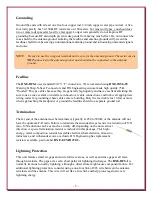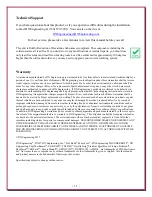
- 4 -
The antenna can be any length between 3/8-wavelength through multiple wavelengths, although we
recommend using lengths similar to those in the table above. In most cases, the
DXE-BFS-1
performance is excellent even when the antenna is not cut to the ideal length.
Location
Beverage antennas work well and are easy to install; you can make reasonable height changes,
drape the antenna over tree branches, and deviate orientation by as much as 10
degrees. Metal poles will not affect the antenna’s performance as long as the
wire is insulated from the pole. Avoid placing the antenna near transmitting
antennas, power lines, large metal fences, or over buried cables. Install the
antenna wires 5-8 feet above the ground. It is not necessary to follow the
contour of the land because small hills, ravines and ditches generally do not
affect the antenna. Contrary to popular belief, sloping the antenna wire does
not improve performance. The picture shown uses typical electric fence wire
holders mounted on top of wooden posts with the beverage antenna wire
strung through.
Connections
The
DXE-BFS-1
Feed Point unit has antenna terminals marked
+
(positive) and
-
(negative). Normally, the
+
side goes to the antenna wire
and the
-
terminal goes to the antenna ground as shown in the drawing
below. When building Beverage arrays, phase can be reversed by simply
reversing the connections. The
DXE-BFS-1
also has ground-isolated
secondaries which are essential for array construction. Do not ground the
case of the
DXE-BFS-1
to the antenna ground system.












